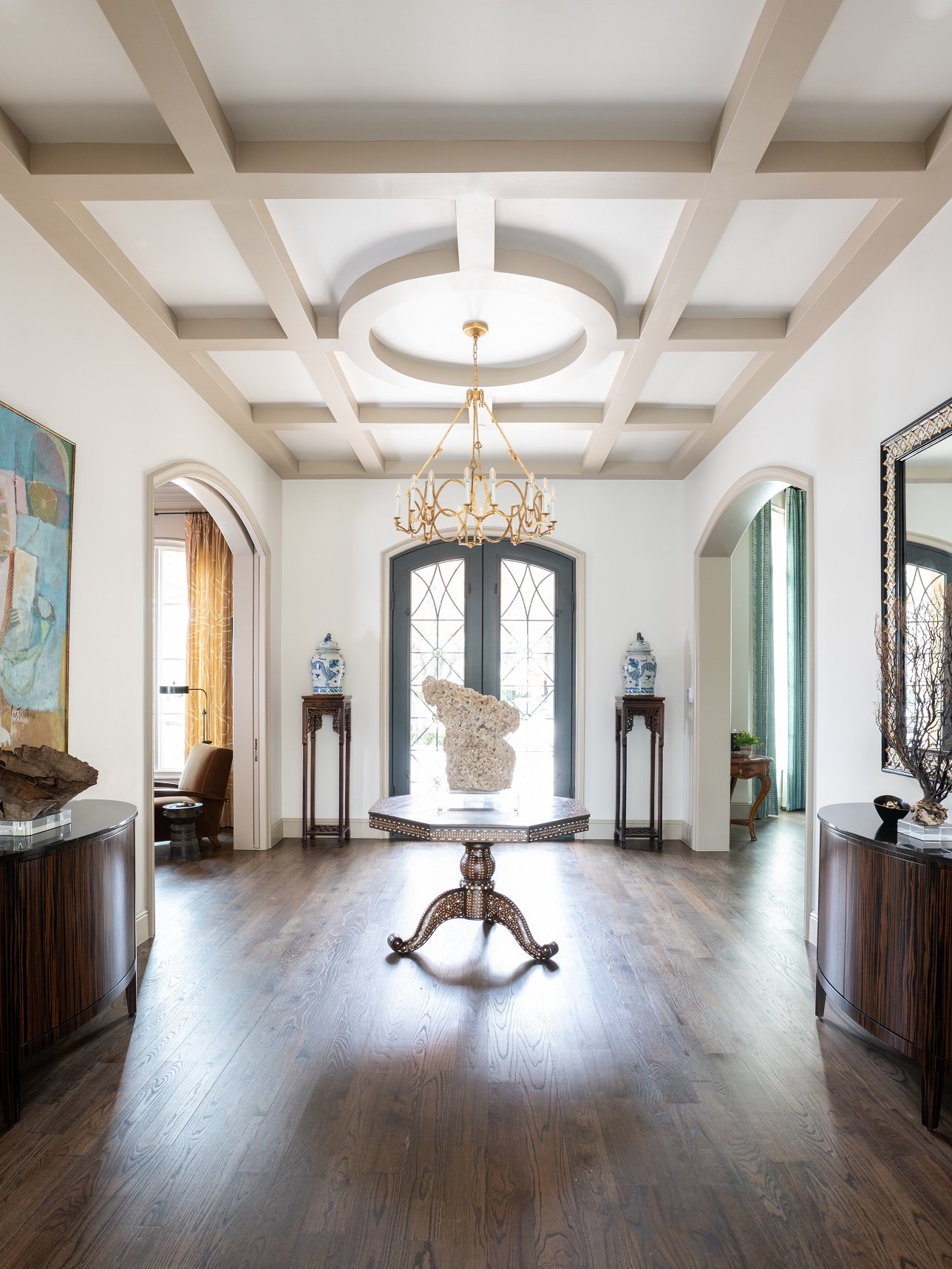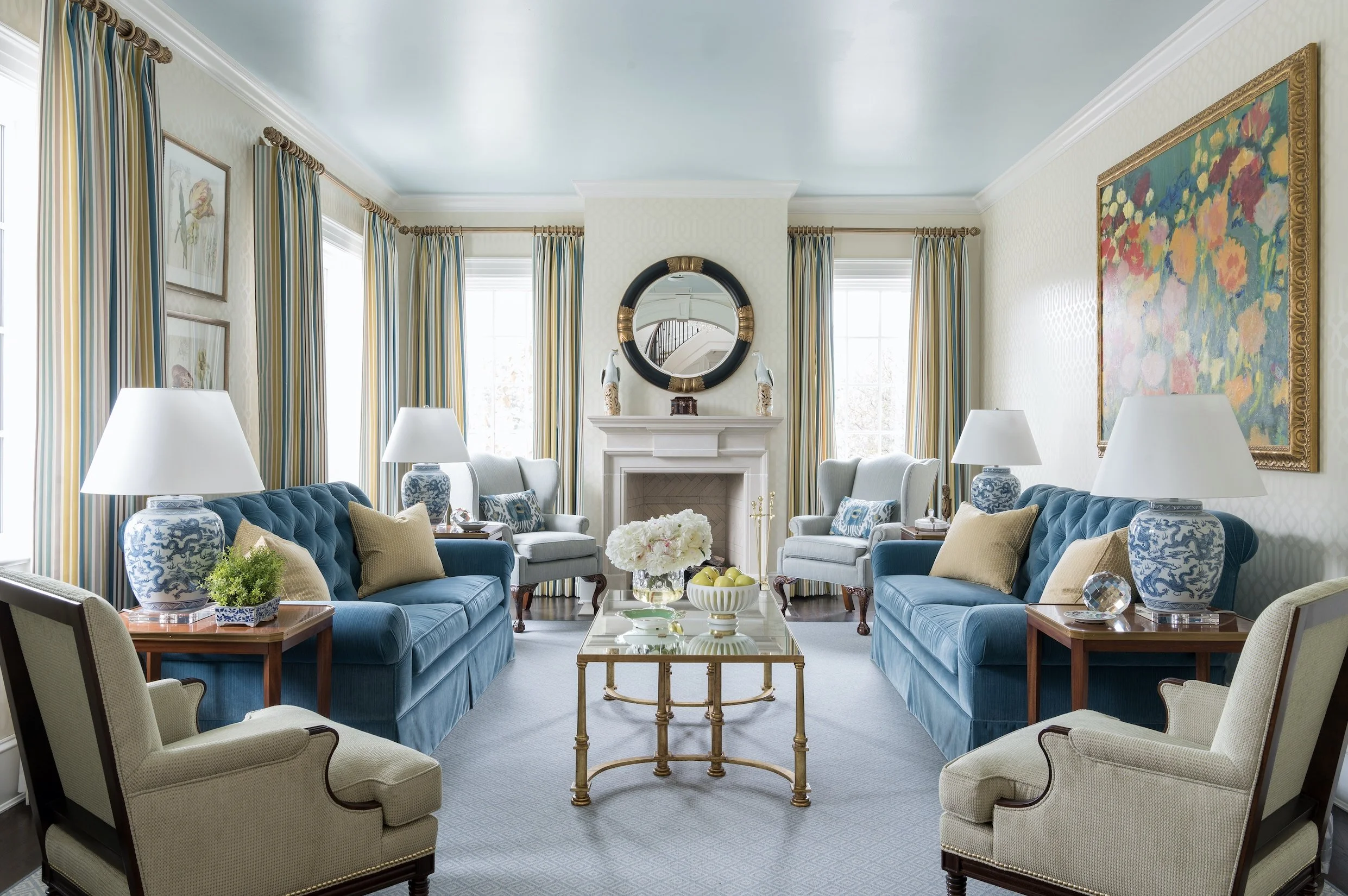A coffered ceiling in a foyer, like this one in a Dallas home we designed, makes a dramatic first impression.
Ceilings are usually the most forgotten part of a room. It’s a shame, because there are so many ways to make ceilings the finishing touch for your interior design. If you’ve made a habit of ignoring your ceilings but are ready to try something new, you’ll be glad to know that there are paint colors, wallpaper patterns, plasterwork, and faux beams that can instantly transform your ceiling from drab to dramatic.
1. Accent Ceilings
We painted the ceiling in the formal living room of SMU's Kappa Alpha Theta house a high-gloss sky blue, reminiscent of southern porch ceilings.
My favorite paint colors for ceilings lately are light blues and light aquas. Blue paint is often used for porch ceilings in the South to deter wasps from building their nests, but increasingly, homeowners are starting to use it for their ceilings indoors.
If you do decide to paint your ceiling a contrasting color, I recommend choosing high gloss enamel or lacquer for the finish. A high-gloss ceiling will reflect the surrounding colors and make the room feel more expansive. However, steer clear of glossy paint finishes if your ceiling has imperfections, as the sheen will make small bumps or cracks more noticeable.
Dark ceiling colors tend to make rooms feel smaller. Interestingly, though, a room with the same dark color on all four walls and the ceiling will not feel small as long as there’s plenty of natural light in the space. For black-painted ceilings, make sure to also use black elsewhere in the room to ensure that the whole design is balanced.
2. Wallpaper
My firm has also been doing wallpapered ceilings for the past few years. In one project, the clients’ existing dining room had a ceiling painted in a dark salmon color. To make the room feel more open, we covered that ceiling with a light, patterned wallpaper. For a contemporary home, you might consider a subtle tone-on-tone pattern or a textured wallpaper, like grass cloth.
The wallpaper we added to this ceiling is a big improvement over the salmon paint color that was there before.
3. Plasterwork
Color and pattern are not the only ways to draw the eye upward to your ceiling. You can also add a three-dimensional element with decorative plasterwork. Designers like myself have been bringing back beautiful plaster ceilings with detailed borders around the edges of the room. I’d recommend using this kind of ceiling in dining rooms, living rooms, and bedrooms. However, you do have to think carefully about light fixture placement.
4. Beams
Running beadboard in the opposite direction of your beams will make a vaulted ceiling more dynamic.
Even if your home didn’t have beams originally, you can always have faux beams added. They should only be installed in rooms with ceilings that are nine feet or higher, or else they’ll make the room feel claustrophobic. I love the look of beams in a vaulted ceiling with beadboard running in the opposite direction. We usually run the beams up and down and the beadboard crosswise.
5. Coffered ceilings
A coffered ceiling is one in which recessed panels are created by adding beams in a grid pattern. Coffered ceilings look best in rooms with nine to fourteen-foot-high ceilings. To add more contrast, you can paint in the recessed sections, wallpaper them, or have them paneled with wood while leaving the beams white. Coffered ceilings are definitely more formal, so you usually won’t see them in rustic or casual homes.
Like coffered ceilings, tray ceilings have recessed areas to give the ceiling depth. The recessed areas resemble upside-down trays. They are great for open concept homes because the recessed areas can act as a reflection for separate zones on the floor below.
In this home office we designed for a Dallas home, the patterned, wallpapered ceiling matches the curtains.
For those of you who like the idea of a painted, wallpapered, beamed, or coffered ceiling, but are having trouble deciding between them, try looking at interior design magazines or Instagram and pay attention to the ceilings you see. If you’re still drawing a blank, the next best step would be to consult with an interior designer like myself. An interior designer will know which ceilings in your home would look best if left white, which could benefit from wallpaper, and which rooms would be perfect for a showstopper like a coffered or plasterwork ceiling. To schedule a free consultation with us, email us at info@chambersinteriors.com or call us at 214-651-7665.





